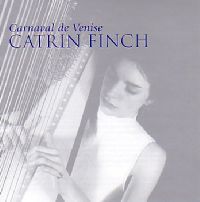| Carnaval de Venise Catrin Finch |
Carnaval de Venise is one of Catrin Finch's earliest CDs on which she performs a stunning international programme of music for the harp. Remarkable performances from one of the brightest stars in the harp world today. Buy this album now CD: £12.98 + p&p |
| Catrin Finch Profile & index of recordings and sheet music |
| J S Bach (1685-1750) | ||
| Italian Concerto | ||
| 1 | i | 4.10 |
| 2 | ii | 5.01 |
| 3 | iii | 4.10 |
| Paul Hindemith (1895-1963) | ||
| Sonata | ||
| 4 | i | 5.25 |
| 5 | ii | 2.16 |
| 6 | iii | 3.45 |
| 7 | Gabriel Faure (1845-1924) Impromptu - Opus 86 |
9.14 |
| 8 | E. Parish-Alvars (1808-1849), Introductions and Variations, on themes from Bellini's 'Norma' |
11.06 |
| 9 | Carlos Salzedo (1885-1961) Ballade - Opus 28 |
9.39 |
| 10 | John Thomas (1826-1913), Bugeilio'r Gwenith Gwyn - Watching the Wheat |
3.48 |
| 11 | Felix Godefroid (1818-1897) Carnaval de Venise |
10.26 |
Sleeve Notes Italian Concerto - I.S. Bach 1685-1750 It is interesting to note that Handel was writing original music for the harp at the same time, and of course, musicians were always borrowing from each other's repertoire. The Italian Concerto sounds particularly well on the harp. The first movement has a fanfare-like opening and this "tutti" is artfully contrasted with 'solo' passages. The slow movement is remarkable for the lovely long melodic line which is spun over a simple bass and thirds which act as a harmonic counterpoint. The last movement is full of exciting scales, fascinating counterpoint and rushes headlong to a magnificent close. Sonata - Paul Hindemith 1895-1963 Mässig-Schnell - Lebhaft - Sehr
Langsam Written for Clelia Gatti Aldrovandi in 1939, the Harp Sonata is romantic in nature though classical in structure. The third movement, "Lied" is prefaced by one of Hòlty's poems, and this becomes the 'argument' of the whole Sonata. The first movement suggests the massive architecture of the Church, the second - a scherzo, children playing games, and the third follows the words of the poem. In fact, the words can be scanned with the melodic line.
The Impromptu, which was commissioned in 1904, is unusual as it lacks the rhapsodic flow found in many of his compositions. Instead he juxtaposes a theme in noble chords with melodic fragments of nocturnal beauty. The second part again announces the initial theme (this time in Arpeggi) and moves toward two variations of suspended magic and a brilliant coda. It is now known that the dedicatee, Alphonse Hasselmans, had a hand in the composition. Some of the figurations in the second half come from him. As the manuscript is lost, we shall never know to what extent he wrote, or re-wrote certain passages. However the piece remains in every harpist's repertoire, an important addition to recital programmes. Introduction and Variations - Op.
36 - Elias Parish Alvars 1808-1849 He was born in Teignmouth, Devon, and subsequently studied with Dizi Labarre and Bochsa. At the age of sixteen he was already well known as a performer. His successful concert tours took him all over Europe and also to the Middle East. In 1846 he stayed in Leipzig where his friendship with Mendelssohn had a powerful effect on his last compositions. In 1847 he settled in Vienna and was appointed Chamber Musician to the Emperor. He died there in 1849. He made many arrangements of operatic themes, wrote several concerti, and his legacy of "Bel Canto" pieces is the most prolific and important in the harpist's repertoire. Ballade - Opus 28 - CarIos Salzedo
1885-1961 In 1909 he was appointed harpist to the Metropolitan Opera House, beginning a career in the United States which was to have an important influence on harpists and composers alike. Tiring of the Harp's romantic image, he wrote compositions which incorporated new sounds and effects. Edgar Varese was one of the first composers to use these effects, assuring the harp a secure and important place in contemporary music. The Ballade appeared in 1914, one of Salzedo's earliest compositions. Of supreme technical difficulty, it is still cast in a romantic idiom, reminding one of Liszt's musical legacy. However there are moments of impressionism and fascinating harmonic progressions. Ingenious chromaticism and repeated notes introduce more modern elements. Watching the wheat - John Thomas
1826-1913 Bugeilio'r Gwenith Gwyn He was prolific as a composer and arranger and is probably still best known for his folk song arrangements, which are often played by harpists today. "Watching the wheat" is certainly the most popular one and in the final variation, the melody is embroidered with delicate arpeggi in the most delightful way. Carnaval de Venise - Felix Godefròid
1818-1897 Programme notes by Professor David Watkins, FGSM, Hon ARAM © 2001 David Watkins |
|||||||||
Credits A digital recording made at Sain Studios,
Llandurrog, in November, 2000. Made in Wales |
| Instruments: | Harp |
| Genre: | Classical |
| Format: | CD |
| Our Ref: | A0127 |
| MCPS: | SCD2280 |
| Label: | Sain |
| Year: | 2001 |
| Origin: | Wales (UK) |
